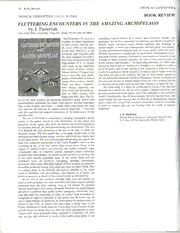
Book Review: Fluttering Encounters in the Amazing Archipelago, by J. Pasternak PDF
Preview Book Review: Fluttering Encounters in the Amazing Archipelago, by J. Pasternak
24 Book Review TROPICAL LEPIDOPTERA BOOK REVIEW TROPICAL LEPIDOPTERA, 12(1-2): 24 (2004) FLUTTERING ENCOUNTERS IN THE AMAZING ARCHIPELAGO by J. Pasternak 2000. Cesky Tesm, Czech Rep. 135pp (23 x 30cm). $75.00 cloth, (no ISBN). Jan Pasternak's 30 years as a remaining tropical forests. It is ironic, and somewhat macabre and manager of rubber plantations grotesque, that lumber companies can clear-cut and literally completely in New Guinea, and his trav- denude whole mountain ranges (hardly different than dropping an els (since 1969) in the island atomic bomb), of forest and undergrowth, and rare plants and animals, world from Indonesia to the all with governmental blessing (and, of course, profit), while the lowly Solomons and Australia, plus butterfly enthusiast or scientist gets lectured about "endangered species" his great fondness for butter- and needs endless numbers of permits to even touch one butterfly or ant flies, have resulted in this new in many of these countries (actually, the same is true even in much of large-format (9 x 12 inches) North America and Europe) — an astounding absurdity of "1984"-type color book on the butterflies hypocrisy that would be worthy of a Nabokov or a Kafka to make a and nature of these islands. novel of were it not so real. All this is not restricted to Southeast Asia, Almost all the 135 pages have it also is on-going in North America, in Africa, and in South America one or more full color photo- (the latter not just in the Amazon, but also in such remote regions as graphs of butterflies or natural the few remaining temperate forests of Patagonia): Europe is already for scenes from various islands. the most part devoid of original forest except for a few isolated patches There are three "chapters": in reserves and in some steep ravines that somehow escaped the axe. New Guinea, Sulawesi, and The book really is a focus on a little-known world of the rare and Java. About half the book per- beautiful that should be sent to every lumber company president and tains to New Guinea, both governmental leader in the region, and to the customers in the industrial Papua and Irian Jaya. The fo- world. Unfortunately, few of these persons will ever see this book, and cus of the book involves the birdwing butterflies, many shown with many would not care anyway, but at least all us lepidopterists should metamorphosis sequences, but many other species are also illustrated. have a copy of it, even if for no other reason than to have it available This is one of those rare books — unlike other color books that only to show to visitors who are not familiar with the world of tropical deal with the life histories of various tropical butterflies — that also butterflies. calls into question our rampant destruction of the biodiversity of this natural world. J. B. HEPPNER The text of the book is somewhat of a running commentary on the Florida State Collection of Arthropods, FDACS, DPI, travels of the author, mixed in with discussions on the nature and P. O. Box 147100, Gainesville. Florida 32614 butterflies of the region, plus notes on current conservation prospects (or the lack thereof), all interspersed among the illustrations. The text is in English; the only detraction to the text is the lack of italics for scientific names. The dust jacket has a two-page spread map of the Indonesia and New Guinea region, overlain with birdwings (duplicated on the book cover). The color photographs and printing are superb: the book was composed and printed in the Czech Republic and is as fine a printing as any of the best books from recent years. Some of the images of natural scenery are stunning: the author evidently spent considerable time in climbing various mountain peaks (although, possibly from small planes). It remains surprising that even in Java, one of the most densely populated areas in the world, there still are substantial tracts of rainforest remaining, although increasingly threatened. Other areas, like large regions of New Guinea, are noted by the author as already having been clear-cut since the early 1970s. This is a unique guide to the butterfly and natural splendor of the island world of Indonesia and New Guinea, and entreats us to renew our efforts to preserve as much of this natural world as still possible. In the view of this reviewer, although large areas are already set aside as national parks, one must remember that parks require constant protection from the daily hacking away at the borders by destitute farmers searching for ever scarcer firewood. However, the small farmers are less of a problem than global lumber companies which can "buy" land and clear-cut everything in sight, no matter what butterflies or orangutans or tigers or elephants or rare plants may be in the way, all just to make billions of chopsticks or wood panels for endless tracts of houses in the USA: of course, the same thing is being done in the Pacific Northwest of North America, where large areas of primeval old- growth forests are being clear-cut. One can recall photographs of giant sequoia trees (now protected) being lumbered in California 120 years ago, yet this still continues in much of the world, particularly in the
